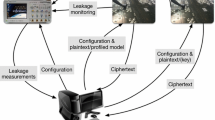Abstract
Electronic devices may undergo attacks going beyond traditional cryptanalysis. Side-channel analysis (SCA) is an alternative attack that exploits information leaking from physical implementations of e.g. cryptographic devices to discover cryptographic keys or other secrets. This work comprehensively investigates the application of a machine learning technique in SCA. The considered technique is a powerful kernel-based learning algorithm: the Least Squares Support Vector Machine (LS-SVM). The chosen side-channel is the power consumption and the target is a software implementation of the Advanced Encryption Standard. In this study, the LS-SVM technique is compared to Template Attacks. The results show that the choice of parameters of the machine learning technique strongly impacts the performance of the classification. In contrast, the number of power traces and time instants does not influence the results in the same proportion. This effect can be attributed to the usage of data sets with straightforward Hamming weight leakages in this first study.
Similar content being viewed by others
References
Aizerman, M.A., Braverman, E.A., Rozonoer, L.: Theoretical foundations of the potential function method in pattern recognition learning. In: Automation and Remote Control, vol. 25, pp. 821–837 (1964)
Backes, M., Dürmuth, M., Gerling, S., Pinkal, M., Sporleder, C.: Acoustic side-channel attacks on printers. In: USENIX, p. 20 USENIX Association, USA (2010)
Bishop C.: Neural Networks for Pattern Recognition. Oxford University Press, USA (1995)
Brabanter, K.D., Karsmakers, P., Ojeda, F., Alzate, C., Brabanter, J.D., Pelckmans, K., Moor, B.D., Vandewalle, J., Suykens, J.: LS-SVMlab toolbox user’s guide version 1.7. http://www.esat.kuleuven.be/sista/lssvmlab/ (2010)
Chari, S., Rao, J.R., Rohatgi, P.: Template attacks. In: CHES, vol. LCNS 2523, pp. 13–28. Springer, USA (2002)
Coron, J.S., Goubin, L.: On boolean and arithmetic masking against differential power analysis. In: CHES, pp. 231–237. Springer, London (2000)
Cortes C., Vapnik V.: Support-vector networks. Mach. Learn. 20, 273–297 (1995)
Gandolfi, K., Naccache, D., Paar, C., G, K., Mourtel, C., Olivier, F.: Electromagnetic analysis: concrete results. In: CHES, vol. 2162, pp. 251–261. Springer, Berlin (2001)
Gestel T.V., Suykens J., Baesens B., Viaene S., Vanthienen J., Dedene G., Moor B.D., Vandewalle J.: Benchmarking least squares support vector machine classifiers. Mach. Learn. 54, 5–32 (2004)
Gierlichs, B., Lemke-Rust, K., Paar, C.: Templates vs. stochastic methods. In: CHES, vol. LCNS 4249, pp. 15–29. Springer, Japan (2006)
Haykin S.: Neural Networks: A Comprehensive Foundation. Macmillan College Publishing Company, Englewood Cliffs (1998)
Jolliffe I.T.: Principal Component Analysis. Springer, Berlin (1986)
Kocher, P.C.: Timing attacks on implementations of Diffie- Hellman, RSA, DSS, and other systems. In: Crypto 96—Advances in Cryptology, pp. 104–113. Springer, UK (1996)
Kocher, P.C., Jaffe, J., Jun, B.: Differential power analysis. In: Crypto 99—Advances in Cryptology. LCNS, vol. 1666, pp. 388–397. Springer, USA (1999)
Messerges T.S., Dabbish E.A., Sloan R.H.: Examining smart-card security under the threat of power analysis attacks. IEEE Trans. Comput. 51, 541–552 (2002)
Mitchell T.M.: Machine Learning. McGraw-Hill, New York (1997)
Quisquater, J.J., Samyde, D.: Electromagnetic analysis (EMA): measures and counter-measures for smart cards. In: Proc. Smart Card Programming and Security. LCNS, vol. 2140, pp. 200–210 (2001)
Rechberger, C., Oswald, E.: Practical template attacks. In: WISA, vol. 3325, pp. 440–456. Springer, Korea (2004)
Rivest, R.L.: Cryptography and machine learning. In: Advances in Cryptology ASIACRYPT, pp. 427–439. Springer, Berlin (1993)
Suykens J., Gestel T.V., Brabanter J.D., Moor B.D., Vandewalle J.: Least Squares Support Vector Machines. World Scientific, Singapore (2002)
Author information
Authors and Affiliations
Corresponding author
Additional information
This work was supported in part by the European Commission’s ECRYPT II NoE (ICT-2007-216676), by the Belgian State’s IAP program P6/26 BCRYPT, by the K.U. Leuven-BOF (OT/06/40) and by the Research Council K.U. Leuven: GOA TENSE (GOA/11/007). Benedikt Gierlichs is a Postdoctoral Fellow of the Fund for Scientific Research, Flanders (FWO).
Rights and permissions
About this article
Cite this article
Hospodar, G., Gierlichs, B., De Mulder, E. et al. Machine learning in side-channel analysis: a first study. J Cryptogr Eng 1, 293–302 (2011). https://doi.org/10.1007/s13389-011-0023-x
Received:
Accepted:
Published:
Issue Date:
DOI: https://doi.org/10.1007/s13389-011-0023-x




